|
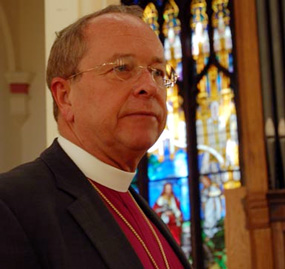
Bishop Gene Robinson describes himself as “...a simple country bishop and a human being-in-training.” That is how Bishop Robinson was introduced by the Reverend Clark West, Episcopal Chaplain to Cornell University to about 300 people gathered in Cornell’s Sage Chapel on April 6, 2011. Robinson, the Bishop of the Episcopal Diocese of New Hampshire, and the first openly gay, non-celibate Episcopal priest to be ordained a bishop, visited Ithaca and the Cornell campus to deliver the 2011 Frederick C. Wood Lecture sponsored by Cornell United Religious Work.
Bishop Robinson’s lecture was entitled "How Religion is Killing Our Most Vulnerable Youth," however, at the outset of his hour-long presentation, he said that his remarks would cover other subjects as well. Among the audience were students and others from the Ithaca community and neighboring areas, including a number of St. John’s parishioners and our own Bishop of Central York, Skip Adams.
Following are some thoughts from Bishop Robinson’s lecture which particularly resonated with me.
Bishop Robinson noted to the gay youth in the audience that coming out as a person of faith to gay friends may be harder than coming out as gay to their straight friends.
He observed how the present controversy about homosexuality within the Anglican communion places us all in a remarkable moment, one in which the Anglican communion is trying to decide how expansive God’s love is. But the Bishop believes this is a worthy struggle to have. He acknowledged how deeply painful it can be as a gay teen of faith; it is difficult enough if a gay teen feels bad about himself but, if he feels that God doesn’t approve of him, it is a truly horrifying thing.
Bishop Robinson feels that, before any of us can discuss whether Scripture attacks homosexuality, we must understand how we regard the Bible. Robinson described the Bible as an account, given over 1,000 years, of a people’s experience of the living God; one that will allow people living later on to learn of it and be able to identify their own experiences. It is a road map: what should we look for when God is reaching out to us? Robinson described the Bible as not so much as a book, but a library. |
Robinson explained the importance of context when trying to understand Scripture meaning: Assume that the game of baseball disappeared in 2011. Then assume that, in the year 3000, someone reading a book that had been written before 2011 came across the term “...out in left field.” Anyone living in 2011 would understand the idiomatic meaning of that phrase, when understanding the context in which it was used (to be “out in left field” is not to know what's going on; taken from the game of baseball in which less capable players are assigned to the outfield where the ball is less likely to be hit by an inexperienced player.). Anyone living in 3000, with no knowledge of baseball, would know the defined meanings of those words, but
would not understand their actual meaning in the context in which they had been written. Therefore, in reading Scripture, we must understand what its words meant to the person who wrote them at that time, as well as what its words meant to the people who heard them at that time.
Scripture has been used to defend slavery and the mistreatment of women, Robinson said. Now Scripture is wrongly being used to speak out against homosexuality. Robinson believes that what appear to be statements about homosexuality in the Bible are not such. He said that same-sex behavior existed in ancient times, but homosexuality did not. The word "homosexual" is used in the Bible because of translations that were made, but homosexual orientation is a notion that is only about 140 years old. He said Scripture is silent about homosexuality.
Bishop Robinson believes, however, that the Scripture is not silent about the fact that people of faith will continue to have experiences with the living God. He cited John 14.25-26, in which Jesus told his disciples on the night before his crucifixion:
“I have said these things to you while I am still with you. But the Holy Spirit, whom the Father will send in my name, will teach you everything, and remind you of all that I have said to you.”
By these words, Jesus told his disciples he only had time to teach them some of what they should know, but the Holy Spirit would come to teach them (and us) more. Bishop Robinson believes it is the work of the Holy Spirit leading us from a place which many thought was settled, but is not. In other words, God’s teachings did not stop with the acts described in the Scriptures; God continues to teach us in the present day.
Bishop Robinson believes that, for people of faith, tolerance of others who are different from us is not the whole journey nor is it even enough. People of faith must work to dismantle tolerance based on racism, sexism, ageism, and heterosexism. Our faith calls us to become active, vocal and committed.
Susie Backstrom |
top of page
Thoughts on Bishop Robinson's Visit to Ithaca
V. Gene Robinson, bishop of the Diocese of New Hampshire, first spoke at Sage Chapel at Cornell University on April 6, 2011. Afterward, he officiated a service at the Anabel Taylor Chapel.
When Gene Robinson spoke at Cornell’s Sage Chapel on April 6, he addressed both the nuts and bolts of the Bible’s position on homosexuality, as well as the broader meaning of and response to his consecration as bishop of the Diocese of New Hampshire. Robinson’s election as bishop of New Hampshire in 2003 ignited debate in the Anglican Communion worldwide and the Episcopal Church in the United States on the role of lesbian, gay, bisexual, and transgendered issues. In his introduction of Robinson, Kenneth I. Clarke Sr., director of Cornell United Religious Work, described him as “one of the most important voices and symbols of that debate."
In explaining the Bible’s position on homosexuality, Robinson said, “I think scripture is completely silent on this subject.” The Bible, he said is an extraordinary account of people who have had an experience with the living God. Each author was captured in history in a context. Only in understanding this can we ask if scriptural directives are binding on us today, he said.
|
For instance, in Romans 1:26-28, Paul appears to condemn both gay men and lesbians. Robinson suggested that the passage be viewed in the context of what Paul may have known about Roman culture at that time. Paul may have been referring to older men using teenage boys. “We would call that child abuse,” Robinson said.
Over centuries, Christians have changed their minds about many scriptural directives and imperatives, Robinson said. Citing the Gospel of John’s teaching that the Holy Spirit will lead you into truth, he suggested that the current time may embody that work of the Spirit in creating greater inclusiveness in the body of Christ.
The church and the world may be on the cusp of an even greater change: the beginning of the end of patriarchy. “White educated males have made most of the decisions for this world—that jig is up,” Robinson said. “The resistance to this struggle is a sign that we are really on to something.”
As people of faith, we must work to dismantle the system that benefits us as the expense of others. “Feeling a little more kindly toward gay people isn’t enough,” he said. “God will not be satisfied with anything but ‘us,’ because there is no ‘them’ to God—only ‘us’.”
Shannon Dortch |
top of page
|
Polio Immunization in India: A Humanitarian Tale
Many of us remember polio from our youth, but some of you may be too young to do so. Our families lived in dread of the infection and our mothers cut several vacations short on rumors of polio in the area. We were forbidden to frequent local swimming pools and beaches and as a result, we were saved from the disease but Edward never became a good swimmer.
Persons of our generation were stricken, a close friend, people we still see today, and neighbors. Even a United States President was stricken. The iron lung, associated in everyone’s mind with polio, was a machine that saved lives but terrified kids, and parents too.
My wife, Janet Steiner, and I became part of the world-wide effort to eradicate polio when we helped immunize children in India in February 2011. Being part of humanitarian mission as Rotarians was both humbling and inspiring.
While the crippling viral infection of polio has been know since the time of the Pharos, by 1964 only 122 cases of polio were recorded in the United States, due to the break-through work of Jonas Salk and Albert Sabin who developed polio vaccines. The World Health Organization certified the Americas polio-free in 1994, the western Pacific region in 2000 and Europe in 2002.
But endemic polio is still crippling children in four countries today: India, Pakistan, Afghanistan and Nigeria. India is tackling the problem through repetitive National Immunization Days, in which as many as 200 million children are immunized or receive a booster.
Teams of health care workers from WHO and UNICEF, local Rotarians, and visiting Rotarians from around the world worked to promote the event, assist with the delivery of the vaccine, and conduct door to door visit to ensure that all children receive the two drops of vaccine that is necessary for a polio free life.
In a country of 1.2 billion people, where once 500 cases of polio were reported each day, only one case of polio has been reported in India in 2011 through mid April. This indicates the tremendous progress that has been made in India, due to the diligence and commitment of Rotary International, the Bill and Melinda Gates Foundation, the World Health Organization, UNICEF, the Government of India, local politicians, religious leaders, other donors, and volunteers.
We joined a group of 35 Rotarians from the United States and Canada on a National Immunization Day (NID) trip. We were based on Delhi, but assigned to work in Ghaziabad, one hour away, a city of one million or more people.
The first event was a Social Mobilization parade, designed to bring awareness of the upcoming NID. The parade included children from dozens of schools, many banners, musicians, horses and the
teams of local Rotarians, and those visiting from Japan, England, New Zealand, the United States and Canada. Snaking through many neighborhoods as well as busy commercial streets, parade participants were greeted with many smiles, waves and a general feeling of excitement. It was a warm day and we walked about 2 miles through Ghaziabad. Everyone wanted to wave at us or shake our hands. There was a general feeling of goodwill and excitement. It was clear that the presence of non-Indian Rotarians gave prestige to the event, and this was designed to remind the community that the NID will happen tomorrow. We were certainly motivated and excited by this event. |
Sunday, February 27 was the National Immunization Day. Teams of six visiting Rotarians were assigned to each of the many many booths located throughout Ghaziabad. The professional health care workers kept records, kept the vaccine cold and handed out vials to those giving the vaccine. All children five and under receive two drops orally. The booth was mobbed with families bringing children—they arrived from all directions, and in all modes of transportation: on foot, by bicycles, motor scooters, motorcycles, wagons, tuk-tuks, taxis and by car. Rotarians worked swiftly, delivering the vaccine and then marking the left pinky of the child to indicate that he or she had been immunized. Stickers and small whistles were given out to all. We had several affluent families who just drove up in their air conditioned cars, opened the windows, thrust the baby out the window who received the vaccine, with pinky marked, all in less than ten seconds.
During lulls, I chatted with young boys who wanted to shake our hands, have photos taken, and get our autographs.
There were some funny moments at our booth; one was when a wandering Brahman bull decided to take a shortcut through our booth to the next street. As he ambled toward me, I stepped aside and he went down the space between the booth and a vendor who in turn yelled at him. The bull then turned into the booth itself making a hole in the side wall and I thought the whole thing would come down around all of us, including the bull. Luckily, these bulls are fairly docile and the local Rotarians shooed him out the back flap of the tent.
At the booth where we worked, 400 children were immunized in a three hour period. When the next shift of local Rotarians arrived to take over we were feeling an adrenaline high while at the same time being somewhat exhausted from physical and emotional energy that we had expended.
The following day, the same groups of six were sent out to accompany the health care workers on follow-up missions, to find and immunize the remainder of the children. By this time, I was feeling the effects of a 24 hour intestinal bug, so Janet alone had the experience of visiting three slums, where, she said, “we could not go door-to-door, as the slums were simply tarps, tents and plastic bags. We attracted a crowd of mostly women and children as we were wearing our brightly colored polio vests and blue baseball caps. We were greeted by smiles and many hands to shake, all wanting their photos taken with the foreigners who had come from the other side of the world to help.”
For me, meeting a local polio victim was one of the defining moments of the trip. I met Ophu when the tour group visited a major tourist site in Agra, and I decided to skip the tour and stayed outside. I approached Ophu and chatted with him for some time, while hawkers and vendors suspended their sales pitches and translated for us.
Now age 22, Ophu was stricken when he was 7, and has been a crippled beggar since then. He walks on his hands and drags his withered legs forward one by one as he moves about.
I told Ophu what we were doing in India and where we were from, but Ophu said, We could have been from the moon - we were so strange to him.
I gave Ophu information about St. Stephens and Dr. Matthew Varghese, but this hospital was at least four hours away from Agra. It was clear from the translators’ skepticism that he probably could not follow up. We think about Ophu every day. We know that our visit helps prevent others from becoming afflicted like Ophu.
Edward Kokkelenberg,
With Janet Steiner
|
top of page
Love Knows No Bounds Experience
by Tina Hallock
“Total life changer!” These are the words I have been using to best describe our recent trip to New Orleans with Love Knows No Bounds, a local nonprofit supporting the recovery effort. Although the organization itself has no specific religious affiliation, it works very closely with someone we at St. John’s know very well.
Pastor Bruce Davenport, minister at St. John’s #5, picked us up quite late on the first Sunday night of vacation. Even though it was almost the next day, Pastor Bruce greeted us with good cheer and asked me to please stop apologizing for bothering him so late. He couldn’t say enough all week about how much LKNB and St. John’s have helped him and his people over the course of time since Katrina.
As some of you have experienced, meeting people who have been humbled by a disaster such as Katrina brings so many emotions to the forefront. The wonderful thing about LKNB is that they are very focused and allow participants to experience the people, culture, and tour devastated areas while doing hands on hard labor resulting in lives changed forever.
We worked on Miss Audrey’s house. Her house sat quite low and after the flood was deemed unlivable, structurally not sound. Builders from Ithaca, the “contractors” for the teams over the last years, shored up the house, saving Miss Audrey’s house. While we all walked into a house that was very roughly framed on the inside, we left a house that was sheet rocked, mudded, molding installed and primed. Kitchen cabinets were installed and a very beautiful brick laden garden dawned the backyard.
Emily, and her Cascadilla friends Angelina and Alvin, accompanied me and nineteen others from Ithaca to help on this project. You can look forward to a presentation by the teens about their experience soon! After exams, they plan to create a powerpoint presentation sharing our experience and would love to come to present it at St. John’s.
I can think of no more rewarding work, kinder people, and an experience that will forever change how I look at each new day.
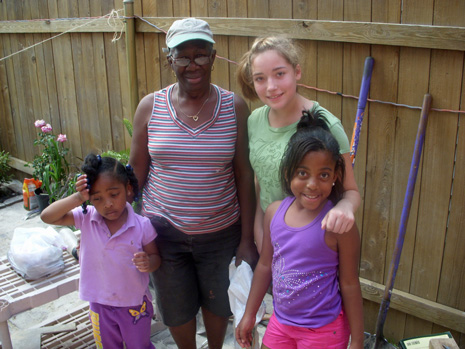 |
Emily with Miss Audrey and friends |
| Final hugs: Tina with Pastor Davenport |
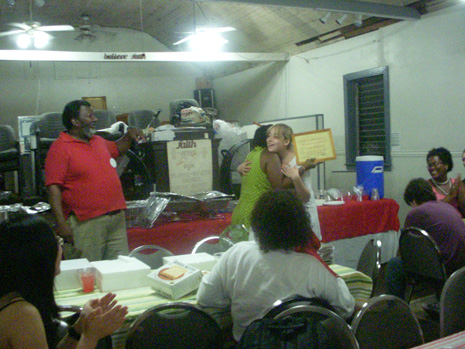 |
top of page
Musical Notes from the Director of Music, Nancy Radloff
First, thanks to everyone for your kind words and support for the musicians during Lent, Holy Week, and Easter. We all worked very hard and everything went very well. Itís true that we offer our music to the glory of God, but itís nice that the congregation notices and appreciates us, too. Thanks, too, to Pam Quirk, Mary Arlin, and everyone else who provided breakfast to the choir between the Easter services. It was wonderful.
Now, of course, itís time to look ahead. We still have almost two months left of the regular program year, but things are winding down. Regular rehearsals will be ending soon, and weíre all looking forward to summer.
But donít worry Ė there is still plenty of work to keep me busy, and plenty of opportunities for you to get involved in our music program. If you enjoy singing, join us in July and August for our ĎCome and Singí choir. Come to the choir stalls at 9:30 AM [or as close to 9:30 as you can] and sing with the choir. Itís a great way to serve God and get to know people. It also makes it possible for some of our Ďregularí choir members to take some time off and worship with their families in the pews. Choir camp will be the last week in August again, and Iím already looking through materials to choose what our project will be this year. Watch the bulletins for a list of requested supplies, and thanks for your generosity.
All the best,
Nancy
top of page
ADULT EDUCATION LECTURE SERIES PLANNED FOR FALL!
Plans are underway to open the fall season at St. John's with an exciting lecture series that will take place every other Wednesday evening until the beginning of Lent. The title of the 12-lecture series is "The American Church in Times of National Crisis." Focus will be on the response of American Churches to the challenges of historic eras, from the Revolution and Abolition to the Great Depression and present-day concerns.
While each lecture will concern itself with a specific period in which Christian churches of differing denominations attempted to deal with spiritual or social problems, speakers will also draw attention to analogous problems that are being addressed (or ignored) today. Speakers for the series will be drawn from our own congregation - including Ed Baptist, Gary Anderson, and Russell Bourne, - as well as from the community at large.
Each session will be preceded by dessert and coffee/tea as well as by a period of prayer. The Christian Education Committee is planning the program.
UTO - United Thank Offering
St. John's, Ithaca received high praise for our donation in the 2010 UTO campaign. Nancy Rancier, Diocesan Coordinator, made a special telephone call to Shirley Durfee to tell her, "St. John's has done a terrific job, better than any other parish. Your donation was larger than any other." How did you do it? she asked. I had to confess that as a new representative for St. John's this year, I could not personally accept her praise. But I assured her I would plan to urge he same trend of generosity in 2011.
On Ascension Sunday, June 5 look for the blue UTO envelopes placed at the end of your pews and give as generously as you are able. An offering envelope will be placed there on All Saints' Sunday, November 6 as well. These funds, collected twice a year, reflect Episcopalians thankfulness for the blessings in their own lives.
United Thank Offering was organized in 1889 to support the work of female missionaries. But in its 122 year history, the UTO goal has spread a much wider net. Last year, the UTO Board received 120 applications for assistance and made 69 grants to individual churches (two in New York State), and around the globe. Please keep UTO work in your prayers as you give. Many thanks for your continued generosity and support.
Shirley Durfee, St. John's UTO Coordinator
top of page
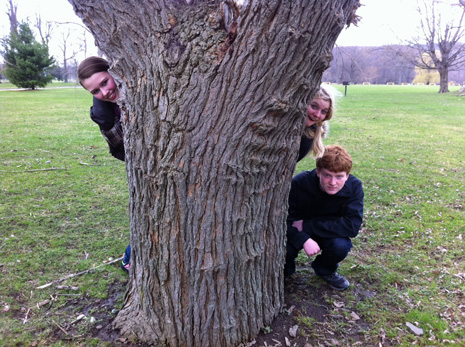
|
Members of the Youth Group at Stewart Park stealthily hiding eggs. Inside the eggs, the youth wrote messages that said "Jesus love you" and enclosed a fresh plump peep. |
| Early birds at Coffee hour on Easter Sunday after the 8:00 a.m. Eucharist. |
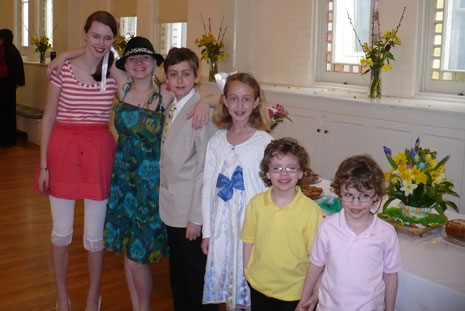 |
The Rev. Clark West, Chaplain of
the Episcopal Church at Cornell
will be our guest preacher and
celebrant on May 22nd. Father. West is
also our district coordinator for the
diocesan project to rebuild the
cathedral in Haiti and will tell us
about this venture. |
St. John's will host the monthly
Healing Ithaca Service
Tuesday, June 7 from 5:15 - 5:45 p.m.
This is a community inter-faith service to pray for and to create healing and connection within Ithaca and Tompkins County through prayer and community building.
We are planning to have some special guests, so please join us. |
top of page
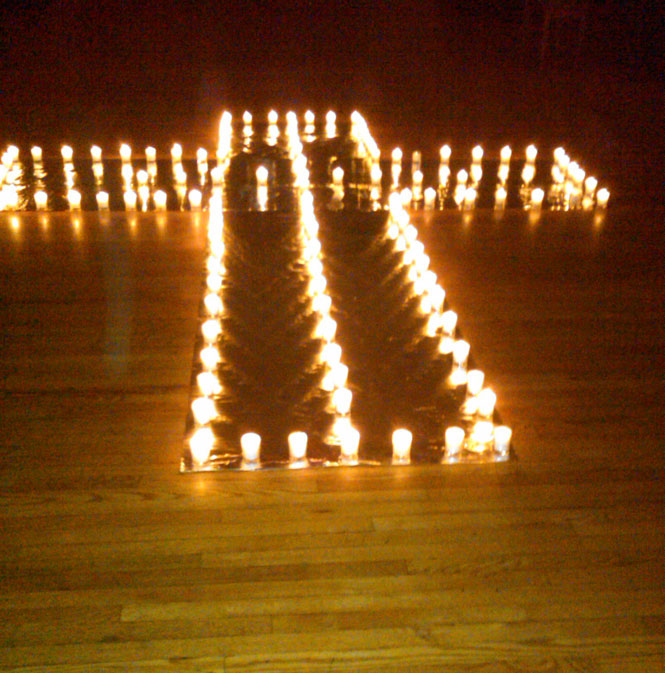
Dear People of St. John's,
I’m very pleased with this issue of the Eagle. It shows that significant reflection about faith and ministry occur far beyond the walls of 210 N. Cayuga Street and that it is not clergy controlled or dominated. It makes me both proud and humbled to be your rector. We are not simply talking the talk; we are also walking the walk.
I would like to add my impression of Bishop Robinson’s visit. I was only able to attend the Eucharist celebrated at Anabel Taylor after the lecture. Many in the congregation were my age, alumni of coming of age in the fifties and sixties. I suspect not a few came to hear a word of affirmation, healing, and hope said on behalf of their children, grandchildren, nieces, nephews and former students who were gay or lesbian. They were not disappointed. In his sermon, Bishop Robinson recalled that thirty or forty years ago, if you asked a gathering to raise their hands if they were friends of someone who was gay or lesbian, very few of the group were likely to raise their hands. Now, in many settings, many hands would go up. As we filed up the aisle for communion, with the Cornell Glee Club singing, I remembered that we’ve come a long way, not far enough to be sure, but nevertheless a long way since my college years, and it’s been courageous people of faith who have made a great difference along the way.
A blessed Easter season to you all.
Sincerely,
Philip W. Snyder, Rector
Home
|